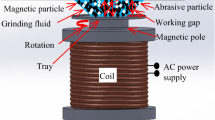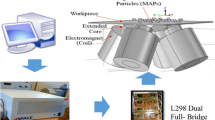Abstract
To solve the problems of the low use rate of magnetic fields and weak magnetic field intensity caused by the use of only a one-sided magnetic pole in the design of the magnetic field device based on permanent magnets in the usual magnetorheological polishing process, a design method and a mathematical model of the dynamic magnetic field device based on the Halbach array are set up in this paper. Through the simulation and experimental research of two different array forms, the ideal magnetic field layout scheme is determined in the form of a circularly symmetrical array, and the effects of process parameters such as the magnetic field speed, the workpiece speed, and the workpiece immersion depth in the polishing pad on the surface roughness of the workpiece after polishing are studied. The orthogonal experimental results show that when the magnetic field is at a low speed of 40r/min, the workpiece is at a medium speed of 650r/min, and the workpiece is immersed in the upper and middle depth of the polishing pad, in which the workpiece can obtain better surface roughness. The research results also show that the dynamic magnetic field device based on the Halbach array can achieve greater changes in magnetic field intensity and gradient with fewer magnets, which provides a reference method for the small and lightweight design of magnetic field devices in magnetorheological polishing.






















Similar content being viewed by others
References
Kordonski W, Golini D (2002) Multiple application of magnetorheological effect in high precision finishing. J Intell Mater Syst Struct 13(7–8):401–404
Pan JS, Yan QS (2015) Material removal mechanism of cluster magnetorheological effect in plane polishing. Int J Adv Manuf Technol 81(9–12):2017–2026
Gleb LK, Gorodkin GR, Gorshkov VA, Khlebnikov FP, Semenov EV (2011) Using magnetorheological methods to process optical items on a series of automated polishing-lapping machines. J Opt Technol 78(4):249–251
Bedi TS, Singh AK (2016) Magnetorheological methods for nanofinishing - a review. Part Sci Technol 34(4):412–422
Xia ZB, Fang FZ, Ahearne E, Tao M (2020) Advances in polishing of optical freeform surfaces: A review. J Mater Process Technol 286:116828
Wu JZ, Yin SH, Yang SJ, Guo YF (2020) Study on magnetorheological nano-polishing using low-frequency alternating magnetic field. Adv Mech Eng 12(1):1687814019900721
Wu JZ, Zou YH, Sugiyama H (2015) Study on ultra-precision magnetic abrasive finishing process using low frequency alternating magnetic field. J Magn Magn Mater 386:50–59
Yang H, Cheng HB, Wu HY, Wang T (2017) Electromagnetic optimization of the integrated magnetorheological jet polishing tool and its application in millimeter-scale discontinuous structure processing. Appl Optics 56(11):3162–3170
Cheng HB, Feng ZJ, WANG Y W, Lei S T, (2005) Magnetorheological finishing of SiC aspheric mirrors. Mater Manuf Processes 20(6):917–931
Xu ZD, Jia DH, Zhang XC (2012) Performance tests and mathematical model considering magnetic saturation for magnetorheological damper. J Intell Mater Syst Struct 23(12):1331–1349
Grover V, Singh AK (2018) Improved magnetorheological honing process for nanofinishing of variable cylindrical internal surfaces. Mater Manuf Processes 33(11):1177–1187
Chen HL, Yang SC, Wang JM, Li WH, Xiong GY (2008) Internal magnetic abrasive particles surface finishing based on permanent magnetic field. Adv Mater Res 53–54:65–68
Yamaguchi H, Shinmura T (2004) Internal finishing process for alumina ceramic components by a magnetic field assisted finishing process. Precis Eng 28(2):135–142
Hoburg JE (2004) Modeling maglev passenger compartment static magnetic fields from linear halbach permanent-magnet arrays. IEEE T Magn 40(1):59–64
Sim MS, Ro JS (2020) Semi-analytical modeling and analysis of Halbach array. Energies 13(5):1252
Chen Y, Zhang KL (2014) Analytic calculation of the magnetic field created by Halbach permanent magnets array. J Magn Mater Devices 45(1):1–5 (In Chinese)
Zhou R, Li GL, Wang QJ, He JX, Wang TT (2020) Drive current calculation and analysis of permanent magnet spherical motor based on torque analytical model and particle swarm optimization. IEEE Access 8:54722–54729
Xu CX, Zhang JZ (2001) Survey of quasi-Newton equations and quasi-Newton methods for optimization. Ann Oper Res 103:213–234
Erway JB, Marcia RF (2015) On efficiently computing the eigenvalues of limited-memory quasi-Newton matrices. SIAM J Matrix Anal Appl 36(3):1338–1359
Ren SF, Gao CQ, Ma RJ (2011) Research on grinding characteristics of ultrasonic aided grinding. Adv Mater Res 197–198:215–218
Funding
This study is supported by the postgraduate innovation funding project of Hebei province (CXZZBS2022130) and Education and Teaching Reform Project of Yanshan University (2020SJJG07).
Author information
Authors and Affiliations
Contributions
Mingli Xie: writing and content analysis; Zijun An: supervising and proof-reading; Jin Zhuang: experiment and data analysis.
Corresponding author
Ethics declarations
Ethics approval
This study follows the ethical standards and corresponding guidelines.
Consent to participate
Not applicable.
Consent for publication
Not applicable.
Conflict of interest
The authors declare no competing interests.
Additional information
Publisher's Note
Springer Nature remains neutral with regard to jurisdictional claims in published maps and institutional affiliations.
Rights and permissions
About this article
Cite this article
Xie, M., An, Z. & Zhuang, J. Design and experimental research of dynamic magnetic field device based on Halbach array in magnetorheological polishing. Int J Adv Manuf Technol 120, 5807–5822 (2022). https://doi.org/10.1007/s00170-022-09134-y
Received:
Accepted:
Published:
Issue Date:
DOI: https://doi.org/10.1007/s00170-022-09134-y




